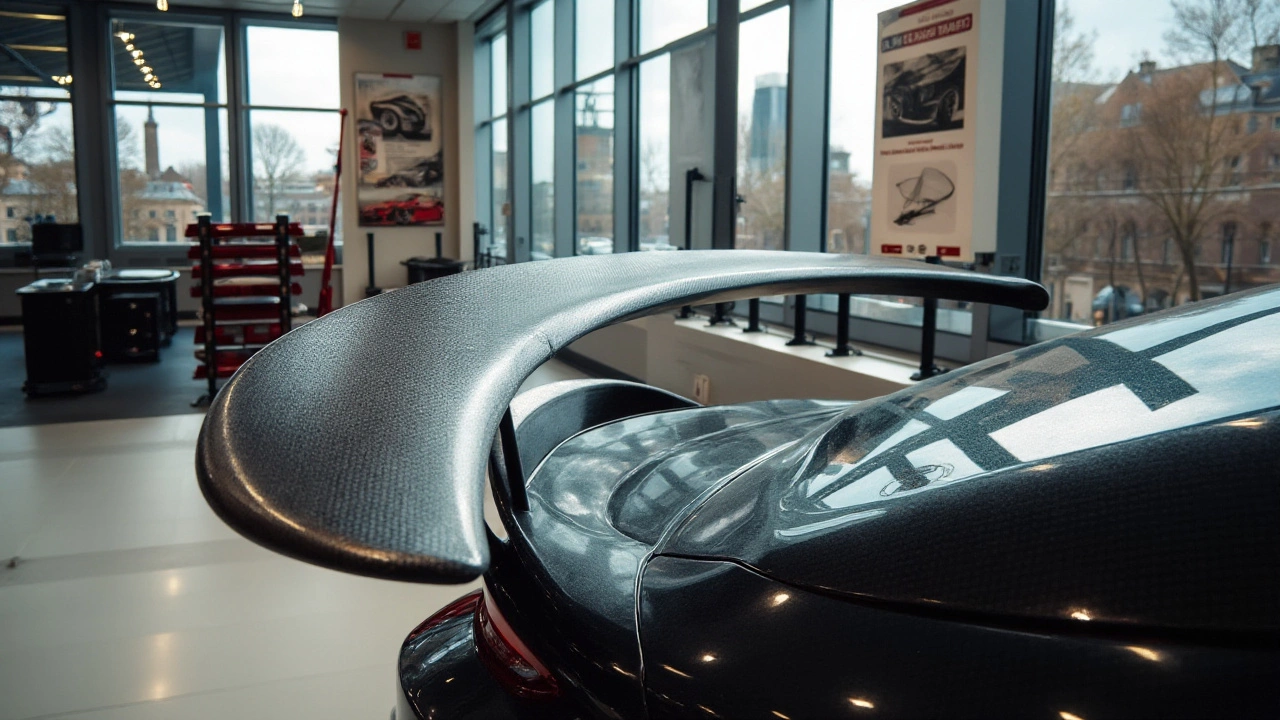The automotive world is constantly evolving, with new technologies and materials transforming the way we think about vehicles. Among these developments, carbon fiber has emerged as a game-changer, especially in the realm of car parts like spoilers. But why are people so drawn to this material? What does it offer that traditional materials like steel or aluminum can't?
Part of the allure lies in carbon fiber's unique characteristics—it's incredibly lightweight yet offers exceptional strength. This means that by swapping out heavier components for carbon fiber alternatives, a car can become more efficient and agile. But the advantages don't just stop at performance. Carbon fiber adds a certain visual appeal to vehicles, with its sleek, modern look catching the eyes of both casual onlookers and fellow car enthusiasts.
As we delve into the world of carbon fiber spoilers, we'll explore how this material has cemented its place in the automotive industry, offering both functional and aesthetic benefits that have captured the imaginations of drivers everywhere.
- History and Evolution of Carbon Fiber in Cars
- Performance Benefits of Carbon Fiber Spoilers
- Aesthetic Appeal: Style Meets Function
- Economic Considerations: Worth the Investment?
- Tips for Choosing the Right Carbon Fiber Spoiler
- Recent Trends and Innovations
History and Evolution of Carbon Fiber in Cars
Carbon fiber's journey into the automotive world is a fascinating tale of innovation and persistence. Originally developed during the 1960s for aerospace applications, this remarkable material quickly caught the attention of automotive engineers. Its allure lay in its unmatched strength-to-weight ratio, a feature so desirable that manufacturers began to explore its use in race cars. It was in the world of Formula 1 racing, where every gram counts and speed is king, that carbon fiber first found a prominent role. Teams sought every possible advantage, and soon realized that lighter cars meant faster speeds. By the 1980s, carbon fiber had become a staple in F1, birthing a new era of race car design.
The transition of carbon fiber from the track to the road took some time. Initially, high production costs and complex manufacturing processes limited its use to high-performance cars and prototypes. However, the 1990s saw a gradual shift, as advances in technology began to reduce costs. Manufacturers started to experiment with carbon fiber in sports cars, primarily in parts like hoods and spoilers. This decade set the stage for what was to come, as car enthusiasts embraced the benefits of carbon fiber spoilers and other parts, eager to boost their vehicles' performance.
Moving into the 21st century, the use of carbon fiber in ordinary vehicles became a reality. Recent years have witnessed a significant expansion of its use, not only due to its performance benefits but also its aesthetic appeal. Today, carbon fiber symbolizes a blend of cutting-edge technology and luxurious style, coveted by car aficionados worldwide. Companies have refined their techniques, developing new weaving patterns and production methods to bring this once-exotic material to a broader audience. As a result, carbon fiber parts are no longer just for elite supercars; they are increasingly found in more mainstream vehicles, offering an option for drivers seeking a personal touch of innovation.
"The evolution of carbon fiber in cars isn't just about performance enhancement; it's a testament to human ingenuity and the relentless pursuit of excellence," says Dr. Emily Sinclair, a renowned automotive materials expert.
Despite its growing popularity, the future holds even more potential for carbon fiber. Researchers are continually exploring ways to make it more sustainable and cost-effective, fueling its potential rise in the era of electric vehicles, where weight reduction directly translates to increased battery efficiency. As the materials science community delves deeper into this quest, car manufacturers are keenly observing, poised to integrate the next advancements into their designs.
Performance Benefits of Carbon Fiber Spoilers
One of the most significant reasons enthusiasts opt for carbon fiber spoilers is their lightweight nature, which plays a crucial role in improving a car's performance. Spoilers crafted from carbon fiber are impressively light yet incredibly strong, a combination that's hard to come by. This reduction in weight translates to an increase in speed and agility for the vehicle. Imagine shedding several kilograms off your car simply by swapping out your conventional spoiler—it's like giving your car wings without the added drag. The decreased weight also enhances handling, allowing drivers to navigate sharp turns with greater precision and less effort.
Beyond the weight aspect, carbon fiber is notably adept at enhancing aerodynamics. These spoilers adjust the airflow around a vehicle to reduce lift and increase grip, particularly at higher speeds. When you're driving on a highway, the feel is noticeably more stable, as if the car is glued to the road. This enhanced traction not only affects straight-line stability but also contributes to improved cornering capabilities. You'll find many racing aficionados and sports car makers harnessing these aerodynamic advantages to minimize lap times.
Another perk of carbon fiber is its ability to withstand stress. Unlike materials that may flex and deform under duress, carbon fiber maintains its integrity across various conditions. This robust composition ensures that the spoiler continues to function effectively throughout its lifespan, providing continual downforce where it's needed most. It's no wonder why many motorsport teams choose carbon fiber components for their endurance vehicles. The longevity translates to savings in the long run, since fewer replacements might be necessary.
Moreover, there's a touch of novelty to modern carbon fiber car parts that traditional metals often lack. The woven pattern of carbon fiber adds a touch of luxury, but it's not just about appearances. The material can be fine-tuned to affect its stiffness and strength characteristics, making it incredibly versatile to meet the demands of specialized driving conditions. This means that a well-designed carbon fiber spoiler is not just a static piece but part of a dynamic system that actively elevates the driving experience.
"Carbon fiber's strength-to-weight ratio is what makes it such an important material in modern vehicle manufacturing," notes Dr. Evan Molden, a researcher in advanced automotive materials.Add to these benefits the slight improvement in fuel efficiency due to the reduced weight and improved aerodynamics. It's clear to see why carbon fiber spoilers are a choice packed with performance pay-offs. Enthusiasts looking to enhance both the feel and efficiency of their vehicles often find carbon fiber is worth the investment just for this.

Aesthetic Appeal: Style Meets Function
When it comes to the allure of carbon fiber spoilers, it's not just about pounds saved or split seconds shaved off lap times. For many automotive enthusiasts, the aesthetic transformation that these parts bring to their vehicles is just as significant. The sleek and often understated look of carbon fiber delivers a strong visual statement of sophistication and modernity. Fans of this material often mention how it seamlessly blends with the lines and curves of their cars, enhancing them without overpowering the overall design.
Carbon fiber's distinctive weave pattern is what immediately captures the eye. This intricate design, usually in a black or dark gray hue, gives vehicles a high-tech, futuristic appeal. The material's natural sheen under sunlight further adds to its desirability. Many car owners say that a carbon fiber spoiler not only looks elegant from afar but also entices closer inspection, where the detail of the weave can be appreciated more intimately. This characteristic has made carbon fiber a choice not just for professional racers but also for everyday drivers looking to add a touch of dynamism to their rides.
Customization is another critical aspect of why these spoilers have become so popular. Car owners relish in the ability to personalize components, and carbon fiber facilitates this with custom patterns and finishes. Whether a matte finish for a stealthy look or glossy for a striking shine, the possibilities are endless. This flexibility allows automobile enthusiasts to express their personality through their vehicles. Customization in carbon fiber spoilers is not just a trend but an evolving form of automotive art, where each creation tells a unique story about its owner.
"Aesthetics in automotive design go far beyond just looks. They inspire the driver and convey the essence of what the vehicle symbolizes," notes renowned car journalist Alex Martinez.
A survey conducted by AutoTrends Magazine found that 65% of car enthusiasts prefer carbon fiber for its visual impact, reflecting a significant interest in style over other materials. It’s this widespread appeal that has led many manufacturers to offer a broader range of products, catering to the growing demand for style-conscious customers. Exotic cars often showcase it prominently, giving a marker of performance excellence and luxury status intertwined with practicality.
Yet, it's not only about visual prowess. The functionality of a well-designed carbon fiber spoiler plays into the aesthetic narrative, merging form with function. Spoilers work to manage airflow over and around a vehicle, reducing drag and increasing stability at speed. When a spoiler is crafted from carbon fiber, both its beauty and purpose are elevated. The fact that it can do all this while looking as sleek as it does is what makes carbon fiber stand out as a leading choice in automotive design.
Economic Considerations: Worth the Investment?
When it comes to upgrading a vehicle, one of the first thoughts that cruises into mind is the cost. Carbon fiber spoilers are no exception, often carrying a price tag that might cause some hesitation. The price difference between carbon fiber and traditional material options like steel or plastic can be significant. But before making a decision, it's worth looking beyond the initial sticker shock to see the bigger picture spanning performance, long-term savings, and resale value.
Carbon fiber car parts, like spoilers, come with a reputation for durability. Unlike cheaper materials which might suffer from rust or quick wear, carbon fiber tends to resist the elements. Imagine a car enduring harsh winters or sizzling summers; the low maintenance and longevity of carbon fiber mean owners save on replacement and repair costs over time. Another layer of reduction in cost comes from improvements in fuel efficiency. The lightweight nature of carbon fiber allows vehicles to consume fuel more efficiently, which can mean noticeable savings at the pump over the vehicle's lifespan.
Moreover, as with any investment in quality, there's the potential for a boost in resale value. Cars adorned with carbon fibers, especially if the components are well-maintained, can catch the eye of potential buyers. These parts often scream high performance, and for automotive enthusiasts, that can be enticing, sometimes justifying a higher resale price. This becomes a key consideration in the used car market where enthusiasts tend to seek out such enhancements.
The True Cost-Benefit
Delving into the numbers, some might wonder about the actual cost-benefit ratio. Consider a car driven an average of 15,000 kilometers annually; the enhanced efficiency of a lighter vehicle can actually amount to a savings of hundreds of dollars each year in fuel costs. Maintenance checks reveal fewer issues due to the high durability of the material, saving money on part replacements or repairs. However, some people argue that mainstream vehicles may not experience enough performance boost to justify such an investment.
"Carbon fiber brings more than just aesthetic appeal; it is a high-performance material that provides tangible benefits in maintenance savings and enhanced resale value," says Martin Hallman, automotive expert at Auto Exposé.
But not everything is about dollars and cents. For many, the value of carbon fiber lies in the intangibles—prestige, style, and the satisfaction of having a machine that performs optimally. Some drivers live for the thrill of the drive, and knowing they have a state-of-the-art component tailored for performance is payment enough.
Choosing Wisely
Decisions related to car upgrades should factor in personal goals and budgetary limits. Not every driver will need or want the added flair and functionality offered by carbon fiber spoilers, but for performance-minded drivers, the investment is often seen as worthwhile. Those who value longevity, enhanced performance, and the sleek aesthetics will likely find these improvements justify the cost. Weighing these aspects and analyzing the specific needs and expectations from the vehicle will help make an informed purchasing decision.

Tips for Choosing the Right Carbon Fiber Spoiler
Choosing the right carbon fiber spoiler for your car can be both thrilling and a bit daunting, especially with the plethora of options available. To make an informed choice, there are several factors you should consider. First and foremost, it's essential to understand the primary purpose of the spoiler. Are you focusing solely on aesthetics, aiming to give your vehicle a more aggressive look, or are you more concerned with performance, seeking to enhance the aerodynamics during high-speed driving? Identifying your motivation helps streamline the options available, allowing you to choose a spoiler that aligns with your goals.
Quality is another critical factor. Not all carbon fiber is created equal, and the manufacturing process can vary significantly from one supplier to another. Always inquire about the weave pattern used in the construction. A 2x2 twill weave is common and offers a balance between strength and weight, but the choice might differ based on personal preference and specific vehicle requirements. Additionally, it's worth looking into the curing process, as a poorly cured carbon fiber can lead to issues like cracking or separation over time, detracting from both the look and function of the part.
Fitment is something you simply cannot overlook. A spoiler that's not specifically designed for your car model might lead to complications during installation and could even fail to deliver the desired aerodynamic benefits. Opt for spoilers that are specifically crafted for your make and model. If you're unsure or can't find the exact match, consulting with a reputable car modification shop can be incredibly beneficial. They can provide insights and possibly recommend custom solutions that will ensure a perfect fit while keeping your car's specifications in mind.
Budget considerations are also important. While you might be tempted to go for the flashy, high-ticket items believing more expensive means better, this isn't always the case. Evaluate what you're getting for the price. Sometimes, mid-range spoilers offer the same quality and features as their costlier counterparts. In some cases, a higher price tag only signifies the exclusivity of a brand name, not necessarily superior performance or durability.
Don't forget about legal restrictions. Some regions have specific regulations about vehicle modifications, including the dimensions and designs of spoilers. Before making a purchase, it might be wise to check your local laws to ensure your choice complies with all necessary road regulations. Otherwise, you could find yourself in a bind, potentially having to remove the spoiler and seek alternative solutions.
Finally, consider the installation process. While some automotive enthusiasts relish the challenge of a DIY project, others might prefer professional installation, where precision and expertise can make a considerable difference. Even if you're planning to install it yourself, advice from professionals or thorough research through credible sources could prove invaluable, minimizing the risk of any mishaps.
Recent Trends and Innovations
In the world of automotive technology, carbon fiber spoilers have seen some exciting and innovative developments recently. As car manufacturers continue to push the boundaries of design and efficiency, the role of carbon fiber has become even more crucial. From advancements in manufacturing techniques to the introduction of new composite materials, the landscape is ever-evolving. One recent trend is the use of 3D printing in the production of carbon fiber parts. This technology allows for more precise and intricate designs, making the spoilers not only lighter but also more aerodynamically efficient. Additionally, 3D printing reduces waste, contributing to more sustainable manufacturing practices.
The integration of smart materials is another fascinating trend. Engineers are experimenting with hybrid composites that combine carbon fiber with other materials to create multi-functional components. These smart materials can change shape or stiffness in response to driving conditions, providing dynamic control over aerodynamics. Imagine a spoiler that adjusts itself in real-time to reduce drag or increase downforce based on the speed of the car. This is no longer the stuff of science fiction but a reality being explored in high-performance vehicles.
There's a significant shift towards customization as well. Car enthusiasts are now looking for parts that not only boost performance but also reflect their personal style. Custom carbon fiber spoilers are becoming increasingly popular, with bespoke designs and finishes available. Whether it's a classic weaved pattern or something entirely unique, the market is opening up to allow more personalized choices. This trend is being embraced by both aftermarket brands and car manufacturers themselves, offering factory-installed options that were previously available only as add-ons.
Additionally, the push for more sustainable automotive solutions has led to innovations in recycling carbon fiber materials. Companies are developing methods to reclaim and reuse carbon fiber from retired parts, significantly reducing the environmental impact associated with discarding these high-tech materials. It's an exciting time, as these efforts not only make the industry greener but also reduce costs, making high-performance parts more accessible to a broader audience.
"Reducing waste and improving resource efficiency in carbon fiber production is a milestone towards sustainable automotive manufacturing," noted an industry expert in a recent interview.
Meanwhile, manufacturers are experimenting with eco-friendly production processes, aiming to reduce the carbon footprint of these materials. Efforts include using renewable energy in production facilities and sourcing carbon fiber from suppliers committed to sustainable practices. Some companies have even started to explore bio-composites, mixing natural fibers with carbon fiber to produce equally strong but more environmentally friendly components.






